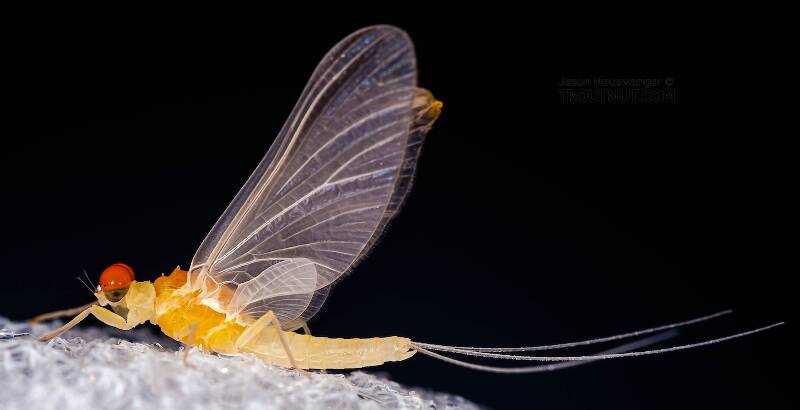
Hex Mayflies
Hexagenia limbata
The famous nocturnal Hex hatch of the Midwest (and a few other lucky locations) stirs to the surface mythically large brown trout that only touch streamers for the rest of the year.
Featured on the forum

Troutnut is a project started in 2003 by salmonid ecologist Jason "Troutnut" Neuswanger to help anglers and
fly tyers unabashedly embrace the entomological side of the sport. Learn more about Troutnut or
support the project for an enhanced experience here.
GONZO on Oct 28, 2008October 28th, 2008, 11:52 am EDT
It's been my suspicion for quite some time that a good part of the credit given to dorothea for creating the later, lighter-colored "little sulphur" hatch should probably go to the same species (or species complex) that creates the earlier, larger, darker hatch--E. invaria. Many anglers who fish the small suphurs on valley limestone streams in my home state believe (or have been led to believe) that they are fishing the dorothea hatch. Close inspection of the mayfly that causes the activity usually doesn't bear that out. Most of the true dorothea hatches seem to come from mountainous areas where the streams are faster and have rockier bottoms.
All of the specimens in this section are from PA, and this seems to provide a good case in point. This specimen and the nymph (#766) are good examples of dorothea, and they both came from sections of the Brodheads in the Poconos. The other specimens came from big limestoners and appear to be invaria. Notice that all of the dun and spinner specimens, except for this one, have banded tails (dark markings at the segments). As far as I know, this is not characteristic of the Eastern version of dorothea (E. dorothea dorothea), but it is a trait of invaria.
All of the specimens in this section are from PA, and this seems to provide a good case in point. This specimen and the nymph (#766) are good examples of dorothea, and they both came from sections of the Brodheads in the Poconos. The other specimens came from big limestoners and appear to be invaria. Notice that all of the dun and spinner specimens, except for this one, have banded tails (dark markings at the segments). As far as I know, this is not characteristic of the Eastern version of dorothea (E. dorothea dorothea), but it is a trait of invaria.
Troutnut on Oct 29, 2008October 29th, 2008, 12:01 pm EDT
Thanks. That makes a lot of sense.
Jason Neuswanger, Ph.D.
Troutnut and salmonid ecologist
Troutnut and salmonid ecologist
TightLine on Jul 22, 2014July 22nd, 2014, 5:39 am EDT
We have these little guys in our spring creeks here in Missouri. They are usually about a size 24. Duns are White/opaque in color with the big orange eyes. The hatch is in the evening from May to October with the prime months June to September. A challenging fly to fish with precise presentations necessary.
McCloud Redband
Entoman on Jul 22, 2014July 22nd, 2014, 3:28 pm EDT
Welcome to the forum, Tightline.
While anything is possible, your tiny flies are probably in one of the baetid genera of Little Sulfur Quills. True PMD's are much larger (14 to 18). If you look closely, you may notice they only have two tails and are either lacking hind wings or they are virtually impossible to make out with eyes older than 35. ;)
While anything is possible, your tiny flies are probably in one of the baetid genera of Little Sulfur Quills. True PMD's are much larger (14 to 18). If you look closely, you may notice they only have two tails and are either lacking hind wings or they are virtually impossible to make out with eyes older than 35. ;)
"It's not that I find fishing so important, it's just that I find all other endeavors of Man equally unimportant... And not nearly as much fun!" Robert Traver, Anatomy of a Fisherman
Quick Reply
Related Discussions
Topic
Replies
Last Reply
0
Jun 29, 2020
by Wiflyfisher
by Wiflyfisher
17
Feb 7, 2012
by Entoman
by Entoman
Re: Anyone know more about Ephemerella septentrionalis?
In the Mayfly Species Penelomax septentrionalis by Troutnut
In the Mayfly Species Penelomax septentrionalis by Troutnut
11
Jul 18, 2011
by Oldredbarn
by Oldredbarn
0
May 6, 2011
by Jtberez
by Jtberez
1
Aug 21, 2007
by Gene
by Gene





